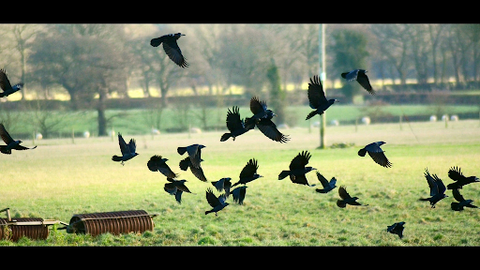
Halloween Edition: How to Keep Out Ravens, Crows, and Grackles
Share
Happy Halloween, Backyard Birders!
Spooky season is officially upon us! While we generally encourage wild birds to flock to our backyards, we also know that there are some we’d rather do without, specifically ravens, crows, and grackles.
These birds can be beautiful, but their notoriously vicious nature and the way they snatch up food before their fellow flyers can get to it has earned them the title of bully birds. That’s downright spooky to us!
We put together some tips on how to deter grackles from your garden.

Chihuahuan Raven perched on a branch. Photo credit: Audubon
Why Bully Birds are a Problem
There are many birds that fall into the bully bird category, among them blackbirds, grackles, American crows, ravens, house sparrows, blue jays, and others. Bully birds tend to feed in flocks and arrange themselves in a way that crowds out other wild bird species. Their aggressive nature prevents more soft-natured wild birds from accessing seed. Sometimes bully birds even stand guard at a feeder they’ve deemed their own and will become hostile towards birds that try to invade their space.

American Crow diving towards prey. Photo Credit: Catalin Grigoriu
Not only are ravens, crows, and grackles bully birds, but they’re also disruptive in their own right. Much like kids running around on mischief, night, these birds create noise, chaos, and sometimes even a little vandalism to buildings and landscaping.
The Trouble With Ravens, Crows, and Grackles
While these birds aren’t all bad, they are known for their not-so-nice demeanor. Here’s a cheat sheet to help you gain a better understanding of the problematic nature of these birds.
Ravens
- Confrontational and aggressive
- Will attack perceived predators
- Noisy and messy
- May cause property damage to buildings & landscaping
- Notorious for strewing around garbage
- May damage crops and other food sources
Crows
- Brazen nature
- Will kill poultry and livestock to feed their young, making them farmers’ enemies
- Will kill smaller wild birds to defend their territory
- Loud and bothersome
- May strike humans who come close to their nests
- Known for stealing eggs and chicks from other bird nests
Grackles
- Serious threat to crops
- Dominant and harmful nature
- Prey on other birds’ eggs and fledglings
- Will steal other songbirds’ food
- May attack people on sidewalks
- Will attack and sometimes kill other adult birds
- Known to invade fields and parks

Common Grackles at bird feeder. Photo credit: Margaret Barse, Alabama Extension Program
How to Keep These Mischievous Birds Out
They may be pretty, but it’s easy to see why you wouldn’t want to attract these songbirds to your birdfeeders. The key to preventing ravens, crows, and other grackles from monopolizing your supply of wild bird feed and to stop them from ruining your lawn is to deter them from coming to you in the first place. Here are some tips to help you manage these birds or prevent them from taking up residence:
- Be strategic about the type of bird feeder you use. Ravens, crows, and grackles are ground feeders, meaning they need to land to get seed. It’s therefore best to avoid using tray feeders and feeders with platforms and instead opt for tube feeders surrounded by cages. With tube feeders in particular, smaller birds like chickadees, titmice, nuthatches, and cardinals will still be able to access food and won’t be crowded out by the larger bully birds.
- Get reflective! No, we’re not talking about in the emotional sense. Crows, ravens, and grackles hate shiny objects. To deter them from coming near, consider hanging old CD’s, silverware, or metallic wind chimes from trees or near your bird feeders.
- Choose the type of wild bird seed you fill your feeders with wisely. Bird food for finches like a finch mix or nyjer seed is great for feeding small birds. Filling your finch feeder (i.e.,a finch sock) with wild finch bird seed will allow birds with small, pointed bills to feed while preventing the bigger birds with larger bills from extracting it.
- Try adding safflower seed to your bird feeders. While grackles will eat just about anything, they’re less likely to flock to safflower than other types of wild bird seed.
- Use cages around suet cakes. Not only is suet a hot commodity, but it’s also a favorite of bully birds like grackles and crows. Consider using a bird feeder that hides the suet under a roof or one that surrounds the suet with a cage. The roof option will be perfect for birds that can hold an inverted position, such as chickadees and woodpeckers.

Murder of crows. Photo credit: Big Think
Cardinal Mix Wild Bird Food
$13.75
Sparrow Resistant Bluebird Nest Box / Bird House $32.80
Valley Farms Wild Finch Mix Wild Bird Food
$15.50

If all else fails, a good old scarecrow should do the trick! Don’t let these spooky songbirds stop you from feeding the sweeter ones.
Many times, these wild bird species arrive in flocks just to hang around for a few days or so. Soon after, they seem to disappear one by one, especially when ground feeding ceases.
Keep the kind birds happy and well-fed with fresh and clean wild bird feed from none other than Valley Farms®. Happy Halloween!



1 comment
I don’t find crows to be particularly nasty or aggressive towards other birds and critters. In fact, they are far more timid than Jays or squirrels when wanting the same foods. Crows will stand back watching jays and squirrels take peanut after peanut if quarters are cramped or other larger animals are too close. Not that they won’t also tear a wounded or sick bird apart when possible… that’s nature, but if you watch closely even chickadees are vicious little balls of fluff at times. Just because the English were a superstitious lot in the 15th century and coined the term “Murder Of Crows” doesn’t mean they are pests or overly aggressive. – https://youtu.be/vHP-a_GyMJ4